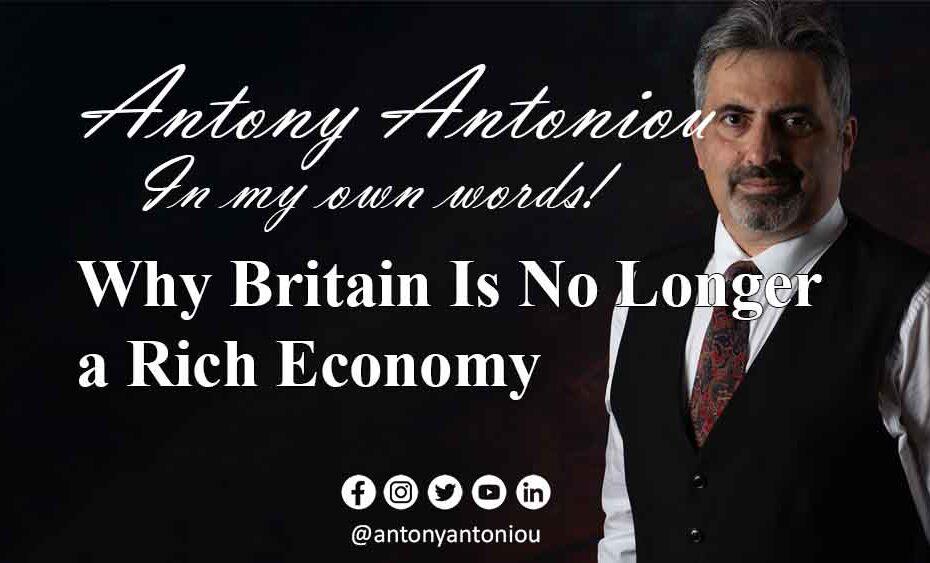Why Britain Is No Longer a Rich Economy
The Illusion of Wealth: Unpacking Britain’s GDP Per Capita
Introduction
Britain’s GDP per capita is an often-cited statistic that appears to paint a picture of prosperity. At $46,400, it suggests that, on average, each British citizen enjoys a comfortable standard of living. However, beneath this seemingly rosy surface, the reality is far more complex. The United Kingdom’s economic journey has been marked by periods of growth, innovation, and challenges. In this blog post, we will delve into the intricacies of Britain’s economic landscape, exploring factors that have shaped its current state, including wealth concentration, low productivity, austerity measures, and the impact of Brexit.
1. The Concentration of Wealth
One of the key aspects of Britain’s economic landscape is the concentration of wealth. While the GDP per capita figure may appear impressive, it masks the stark disparities within the country. A significant portion of the nation’s wealth is concentrated in the southeast, which contributes to 47% of the GDP while housing just 37% of the population. This region is home to opulent country estates, prestigious educational institutions, and high-paying jobs at global corporations. However, beyond this prosperous enclave lies a different reality.
2. Economic Challenges Post-2008
The global financial crisis of 2008 dealt a severe blow to the UK’s economy. In response, the government adopted a policy of austerity, focusing on reducing deficits rather than fostering productivity or addressing aggregate demand. The consequences were dire, with real wages declining for six consecutive years and household income stagnating for over a decade. In comparison to other countries, the UK’s household income growth lagged significantly, exacerbating income inequality and diminishing living standards.
3. The Productivity Conundrum
Productivity is a vital driver of economic growth and well-being, and here the UK faces significant challenges. Despite periods of strong productivity growth in the early 2000s, the global financial crisis triggered a prolonged slowdown. The UK’s productivity growth rate from 2009 to 2022 was among the slowest in the G7 nations. Had productivity continued to grow at pre-crisis rates, GDP per person would be significantly higher today.
4. The Role of Investment
One crucial factor contributing to the UK’s productivity gap is low investment. Investment in capital goods, technology, and human capital is essential for driving productivity growth. However, the UK lags behind comparable nations in business investment rates, R&D spending, and intangible investments such as market research and training. This underinvestment, coupled with a skills deficit, contributes to the UK’s productivity woes.
5. Brexit’s Impact
Brexit, the UK’s decision to leave the European Union, has introduced a new layer of economic uncertainty. The Bank of England estimates that Brexit reduced investment by 25% in the five years leading up to 2021. Importantly, Brexit has also affected immigration, exports, and foreign investment, potentially reducing the UK’s long-term economic growth prospects.
6. Austerity and Social Impact
Austerity measures, implemented to reduce budget deficits, have had limited success in promoting economic growth. Instead, they have been criticized for increasing poverty levels, particularly child poverty. The number of children living in relative poverty has increased since the onset of austerity measures, with approximately 4.2 million children currently living in poverty.
7. A Comparison with Other Anglosphere Nations
When compared to other Anglosphere countries, the UK lags behind in terms of wealth, productivity, and living standards. Americans, for instance, enjoy a significantly higher average income and greater productivity. Housing affordability is also a pressing issue in the UK, affecting young people’s financial prospects.
Conclusion
– Britain’s GDP per capita of $46,400 may seem impressive at first glance, but it masks significant economic challenges within the country.
– Wealth in the UK is highly concentrated, with the southeast accounting for 47% of GDP and 37% of the population.
– The UK’s economic woes began with the 2008 financial crisis, leading to austerity measures that negatively impacted real wages and household income.
– Low productivity growth has been a persistent issue, with the UK’s productivity lagging behind its peers.
– Insufficient investment in capital goods, technology, and human capital has contributed to the productivity gap.
– Brexit has introduced economic uncertainty, reducing investment and affecting immigration, exports, and foreign investment.
– Austerity measures, while aimed at reducing deficits, have been criticized for increasing poverty levels, especially child poverty.
– A comparison with other Anglosphere nations reveals the UK’s lagging wealth, productivity, and living standards.
– To secure a more prosperous future, the UK must prioritize balanced economic policies that promote investment, productivity, and social well-being.
– While challenges persist, there is hope that the UK can navigate towards a more productive and equitable decade ahead.
Britain’s GDP per capita figure may initially suggest prosperity, but a deeper analysis reveals a complex economic landscape marked by wealth concentration, low productivity, austerity’s social impact, and the fallout from Brexit. The UK’s journey from an industrial powerhouse to its current state underscores the importance of balanced economic policies that prioritize investment, productivity, and social well-being. As the UK navigates its economic future, there is hope that a more productive and equitable decade lies ahead. However, addressing the challenges highlighted in this post will be essential to achieving that vision.

